I have been playing a ton of both Apex Legends and Red Dead Redemption 2. Both of these games are at the top of their respective genres. Apex is the most played online multiplayer shooter right now, and Red Dead is one of the bestselling single player games of all time. In my (strong) opinion, the world of Red Dead Redemption 2 lives and breathes. Its characters complete tasks with or without you and its environment responds to your every action. The closest online multiplayer games have come to this amount of character exist in Overwatch and Apex Legends, both of which have shied away from character customization in an effort to inject story into their playable characters. But these characters can only interact with each other and their worlds so much. Their unique ability to bring together people online will always be profitable. Loads of people like me play Apex with their friends halfway across the country, but even more just want to take the reigns as Arthur Morgan, a man with the innate ability to fight for the ones he loves. Arthur Morgan loves over a dozen characters, each of which has a different relationship with him. The difference between Red Dead 2 and Apex is that when a character in Arthur’s world is in danger, I care for that character. When a character in Apex is in danger, I don’t yell, “Lifeline noooooo, I’ll protect youuuuuu!” I yell, “JAKE (my friend’s name), I’M COMING FOR YOU STAY ALIVE!”. The difference here is not minimal. I don’t love the world of Apex Legends. I love interacting with the world of Apex with my friends. Single player games let me experience a world how I want, when I want, with interesting characters that I care about. Single player games are here to live, breath, and die for players.
[2] Arthur Morgan’s beard grows with or without you in Red Dead 2.
[3] Lifeline’s intricate detailing and character design shines bright… but does it even matter?
A great example of a character that has died for players is Ezio from Assassins Creed (AC) 2, AC: Brotherhood. And AC: Revelations. In AC 2, players literally taught Ezio how to move in one game, helped him avenge his family for his entire life in another, and then ceremoniously watched him die in his final game. Players were given a character to learn and grow with, whereas in games like Apex, players are introduced to characters near the middle of their lives, given access to them for a handful of minutes, watched them die, then rinses and repeats until the break of dawn. The next night, the characters are exactly the same and in perfect health. You see, these characters aren’t living without the input of players. My inclination for single players never going away lies in the fact that players like seeing evolution. If in Apex Legends 2 (TBA) these characters are older and more skilled, I think most players would be okay with it. We as humans and storytellers want progression, we want characters to change (for better or worse), and we want characters to learn from each other.
[4] Ellie was a scared little girl back then…
[5] Ellie is a badass now.
My most anticipated games right now are The Last of Us Part II and God of War 2 (TBA). I’m not only excited about the new mechanics and challenges that the devs will throw at me, but because I know that these characters will be older, wiser, and more badass than I ever knew they could be. Ellie will not rely on Joel anymore and (let’s be real here) Kratos will probably die sacrificing himself for his son. We were shown as players that Kratos could become a better father by the end of the game, and now, after almost 20 years of guiding this character’s growth, we will ball our eyes out saying goodbye to him.
To put it bluntly, I don’t see very many Twitch streamers crying when they see Bloodhound die in Apex…
Sources:











![[1] Strong opinions incoming…](https://images.squarespace-cdn.com/content/v1/5a2ea8c8017db2454c71d219/1606378171157-YBUNGREKHXMS5B7JAU8B/YUaWuKQ.jpg)
![[2] Arthur Morgan’s beard grows with or without you in Red Dead 2.](https://images.squarespace-cdn.com/content/v1/5a2ea8c8017db2454c71d219/1554317829917-ZTVRO7239REGCMXYLBPD/bU2LFftsWMwjQDqZ9S8VNZ-1200-80.jpg)
![[3] Lifeline’s intricate detailing and character design shines bright… but does it even matter?](https://images.squarespace-cdn.com/content/v1/5a2ea8c8017db2454c71d219/1554318004351-LF4GS1XIPTN9VOZWWJ2A/apex-section-bg-legends-lifeline-xl.jpg.adapt.1920w.jpg)
![[4] Ellie was a scared little girl back then…](https://images.squarespace-cdn.com/content/v1/5a2ea8c8017db2454c71d219/1554318282842-CDWPZNPLWKXOURJYCDFL/jpg)
![[5] Ellie is a badass now.](https://images.squarespace-cdn.com/content/v1/5a2ea8c8017db2454c71d219/1554318319022-0LZAVIPBNHP4KMBHD3FI/maxresdefault.jpg)




